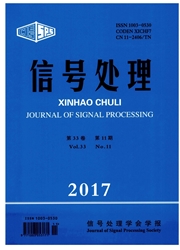

 中文摘要:
中文摘要:
为了实现SAR图像的可变类分割,本文提出了一种基于区域的多尺度可变类分割方法。首先,利用曲波变换对SAR图像进行多尺度分解,获取多尺度曲波系数;然后按尺度由粗-细次序,利用曲波逆变换对各尺度曲波系数进行重构,获取各尺度分解图像,进而获得多尺度分解图像。在此基础上,利用规则划分技术划分图像域;然后利用Gamma分布及马尔科夫随机场(Markov Random Field,MRF)模型建立基于区域的特征场模型及标号场模型;假设图像类别数为随机变量,并服从Poisson分布;并在贝叶斯理论框架下建立基于区域的多尺度可变类分割模型。最后,利用可逆变马尔可夫链蒙特卡罗(Reversible Jump Markov Chain Monte Carlo,RJMCMC)算法,实现该模型求解;在求解过程中,按尺度由粗-细次序,将当前尺度分割解作为下一低尺度分割的初始解,以细尺度的分割解作为最终分割结果。利用提出方法对模拟及真实SAR图像进行可变类分割实验,通过其实验结果验证提出方法的可行性及有效性。
 英文摘要:
英文摘要:
To segment SAR image with unknown number of classes, a region- and multiscale-based segmentation method with unknown number of classes is proposed. The multiscale curvelet coefficients are obtained by decomposing SAR image using curvelet transform. Then every scale coefficients are reconstructed by inverse curvelet transform from coarse to finest scale, and multiscale decomposed image is obtained. On this basis, an image domain is partitioned into a set of blocks by regular tessellation. Gamma distribution is used to build region characteristic field and Markov Random Field (MRF) is used to build region label field. The number of classes is considered as a random variable and subject to a Poisson distribu-tion. Further, the Bayesian paradigm is followed to combine them to build the region-and multiscale-based segmentation method with unknown number of classes. Finally, a Reversible Jump Markov Chain Monte Carlo (RJMCMC) algorithm is designed to simulate the model. In the processing of simulation, the segmentation result of current scale is regarded as the initial segmentation of next scale. And so on, until it gets to the finest scale, the corresponding segmentation is the final image segmentation. The proposed approach is used to segment simulated and real SAR images, and the results point out the feasibility and effectiveness of the proposed approach.
 同期刊论文项目
同期刊论文项目
 同项目期刊论文
同项目期刊论文
 期刊信息
期刊信息
